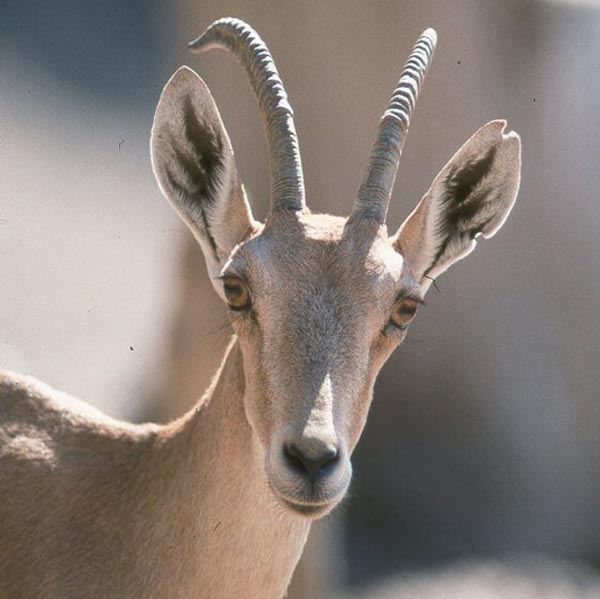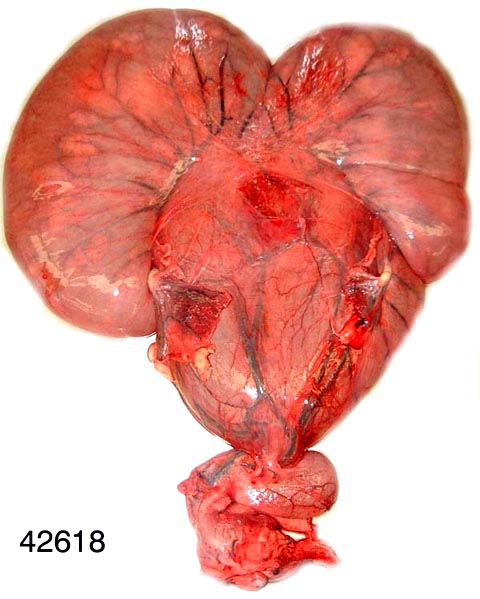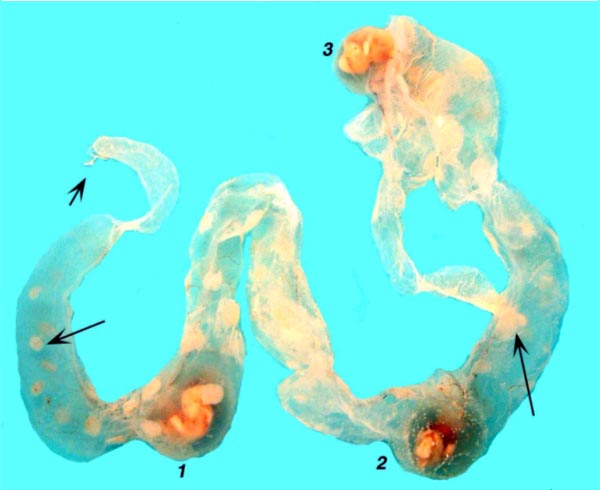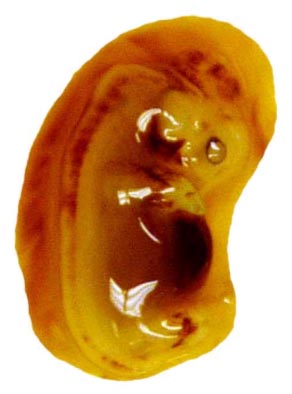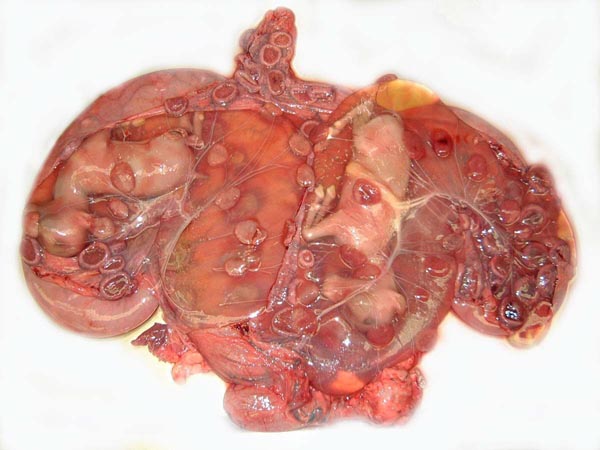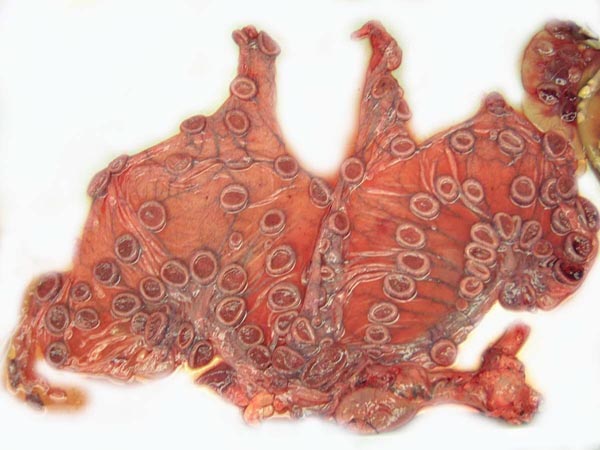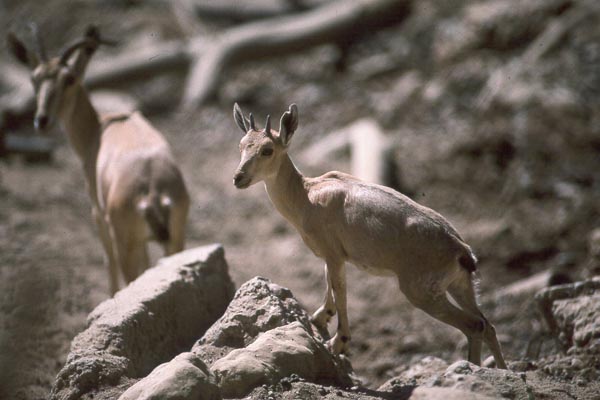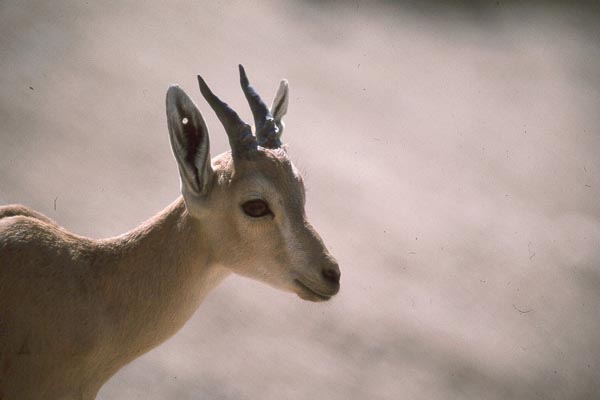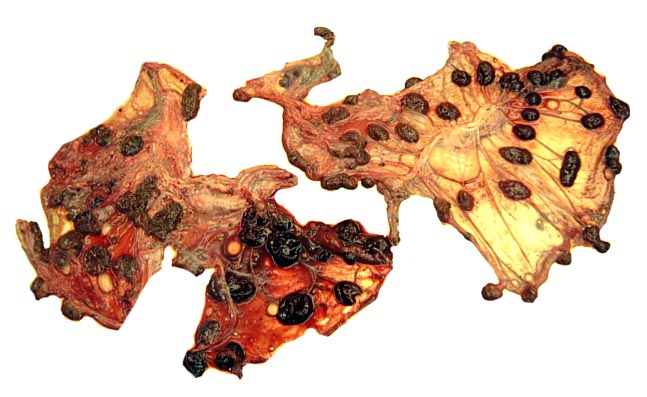 |
Twin placenta of Caucasian tur.
|
| |
|
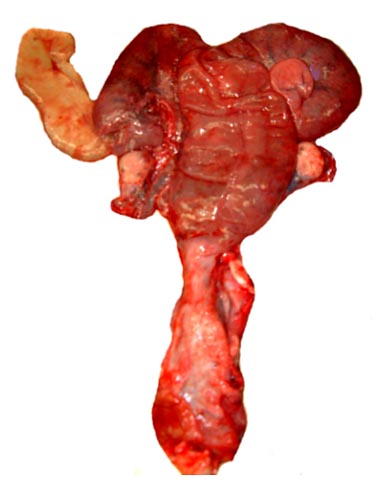 |
Pregnant uterus with twin fetuses from posterior. Note the large pink ovaries.
|
| |
|
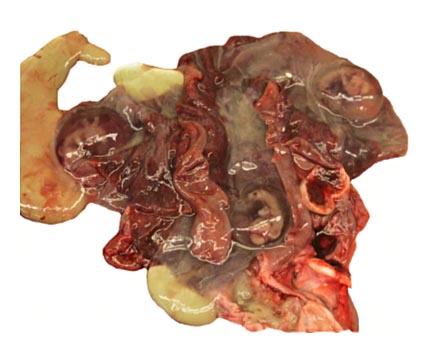 |
The same uterus opened, with small embryos in each horn.
|
6) Umbilical cord
The cord has a midmesometrial location (Mossman, 1987), possesses four blood vessels and a large allantoic duct. It was not spiraled and measured 9 x 1.5 cm at this gestational age. There were no surface callosities. No hippomanes were present in this specimen and there was no vitelline duct.
7) Uteroplacental circulation
No information is available.
8) Extraplacental membranes
The amnio-allantoic partition was very thin, with the delicate allantoic blood vessels easily demonstrable.
9) Trophoblast external to barrier
There were neither extravillous trophoblast, giant cells nor vascular trophoblastic invasion.
10) Endometrium
There was no endometrial decidualization.
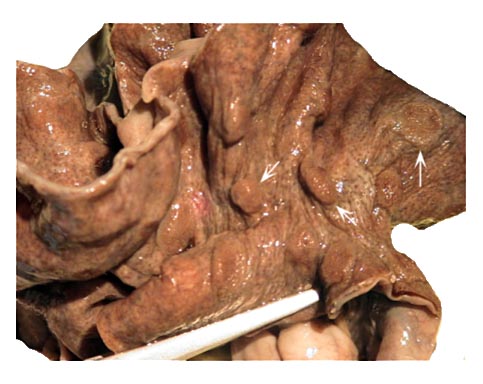 |
Triplet pregnancy after detachment of the immature cotyledons, to show some of the small caruncles in one uterine horn at white arrows.
|
11) Various features
No subplacenta is present.
12) Endocrinology
The estrus is short, 1-2 days (Puschmann, 1989) and seasonal; reproductive maturity occurs at 2 1/2 years. The breeding interval is 1-2 years. The reproductive biology of the close relative, the Alpine Steinbock, has been detailed by Stüwe & Grodinsky (1987). They found them to be seasonally polyestrous with the estrous cycle 20 days long, and a gestational length of 167 days.
While no work has been reported on ibex, there is much information of the placental function in sheep and goat. This is adequately summarized by Porter et al. (1982). It is generally accepted that the sheep placenta produces progesterone in later gestation and becomes independent of the corpus luteum. This does not appear to be the case in goat placentas. For that reason, it is conjectured that sheep x goat hybrid pregnancies are compromised. The generation of gonadotropins from the placenta has not been reported (Courrier, 1945). The contribution by Porter et al. (1982) also discussed relaxin production and onset of labor.
13) Genetics
This species has 60 chromosomes, all acrocentrics, similar to the domestic goat (Hsu & Benirschke, 1969).
Hybridization with Markhor (Capra falconeri) and domestic goat (Capra hircus) has been reported (Gray, 1972). The latter are said to be fertile and they are hornless if a hornless domestic goat was used for the hybridization. When introduced into the wild, they failed to prosper, perhaps because of an unfavorable weather condition at the time of their births (Stüwe & Grodinsky, 1987).
No additional genetic information is available.
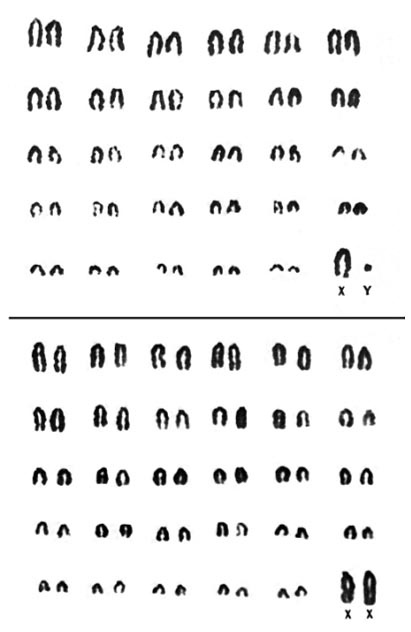 |
Karyotypes of male and female ibex. (From Hsu & Benirschke, 1969).
|
14) Immunology
No MHC molecules, NK cells, or other relevant cell populations have been described for this species.
15) Pathological features
Griner (1983) reported on the mortality of 14 ibex in the collection of the San Diego Zoo; most were due to trauma. Neonatal mortality was very high and one case of hydronephrosis was described.
16) Physiological data
No information is available.
17) Other resources
Cell strains of Nubian ibex are available from CRES at the Zoological Society of San Diego by contacting Dr. Oliver Ryder at oryder@ucsd.edu.
References
Corbet, G.B.: The Mammals of the Palaearctic Region: A Taxonomic Review. British Museum (Nat. Hist.), London, 1978.
Courrier, R.: Endocrinologie de la Gestation. Paris, 1945.
Gray, A.P.: Mammalian Hybrids. Second edition. A Check-List with Bibliography. Commonwealth Agricultural Bureaux, Farnham Royal, Slough, UK, 1972.
Griner, L.A.: Pathology of Zoo Animals. Zoological Society of San Diego, 1983.
Hsu, T.C. and Benirschke, K.: An Atlas of Mammalian Chromosomes. Vol. 3, Folio, 140. Springer-Verlag, NY, 1969.
Mossman, H.W.: Vertebrate Fetal Membranes. MacMillan, Houndmills, 1987.
Nowak, R.M. and Paradiso, J.L.: Walker's Mammals of the World, Vol. II. 4th edition. The Johns Hopkins University Press, Baltimore, 1983.
Porter, D.G., Heap, R.B. and Flint, A.P.F.: Endocrinology of the placenta and the evolution of viviparity. J. Reprod. Fertil., Suppl. 31:113-138, 1982.
Puschmann, W.: Zootierhaltung. Vol. 2, Säugetiere. VEB Deutscher Landwirtschaftsverlag, Berlin, 1989.
Stüwe M. and Grodinsky, C.: Reproductive biology of captive Alpine ibex (Capra i. ibex). Zoo Biol. 6:331-339, 1987.
|
